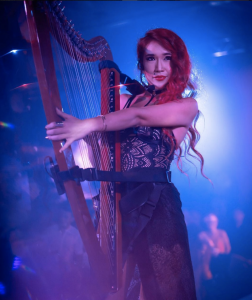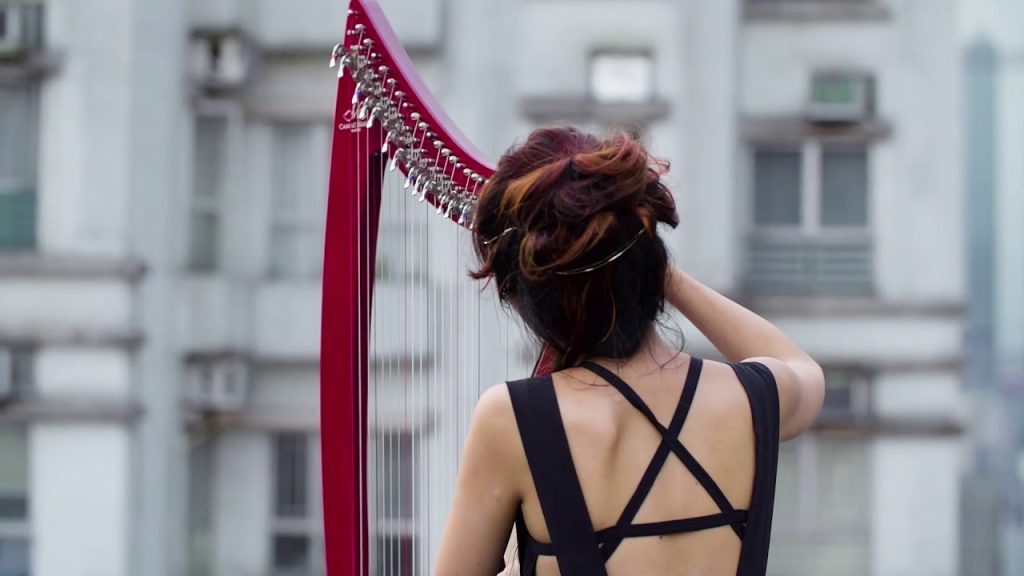Camac Blog
She’s Electric…
Latest
February 17, 2020
Our DHC electric harp has quite a story behind it. The instrument was born from Deborah Henson Conant’s inspired idea, hence its name. Electric (solid-body) lever harps had existed since the early 1980s, but Deborah – hip harp legend that she is – wanted an ultralight electric instrument that she could wear, and move about with onstage. This harp’s development was, at the time, a leap of faith: a big investment with an unknown outcome, but one that ultimately surpassed all expectations. Today, the DHC is a worldwide benchmark.
The fact that the DHC has made it possible to move freely with the harp, has brought a new wind to modern harp playing. It can participate fully in pop music aesthetics, no longer hiding the artist behind a static frame. Increasing numbers of harpists are turning this possibility into a new art form.
One such artist is Héloïse LaHarpe, a French Vietnamese harpist and singer. Based in Hong Kong and Singapore, she is constantly touring the Asia Pacific region, creating high-octane shows for everyone from Formula One, to the Manila Silent Film Festival. She learnt the harp as a child, but later studied audio design. Following an injury, she had to stop playing, and turned to singing instead. By the time she had recovered, the DHC had been launched, and it caught her attention. She acquired a DHC 32 in a striking bright red, and began combining the harp with song, electronica, dance, a strong visual identity, and multimedia presentation.
 Sound processing has brought effectively limitless possibilities to instrumentalists. You can be almost inaudible or deafen the largest stadium, or distort your sound beyond all recognition. MIDI can make a harp sound like a trumpet, or the voice of George Bush (we’re still waiting for the rush of orders on that, but technically, it can be done). These infinite horizons incite new questions about instrumental identities in the twenty-first century. “I use a lot of processing, because electronica is my principal interest”, Hélöise LaHarpe remarks. “But I don’t ever make the harp invisible. So I’ll use delay, but rarely distortion – the sound of the harp is always present. It’s always at the centre of all my shows, it’s not an accessory. Like this, I’d like to show audiences that the harp has many faces and can do many things.”
Sound processing has brought effectively limitless possibilities to instrumentalists. You can be almost inaudible or deafen the largest stadium, or distort your sound beyond all recognition. MIDI can make a harp sound like a trumpet, or the voice of George Bush (we’re still waiting for the rush of orders on that, but technically, it can be done). These infinite horizons incite new questions about instrumental identities in the twenty-first century. “I use a lot of processing, because electronica is my principal interest”, Hélöise LaHarpe remarks. “But I don’t ever make the harp invisible. So I’ll use delay, but rarely distortion – the sound of the harp is always present. It’s always at the centre of all my shows, it’s not an accessory. Like this, I’d like to show audiences that the harp has many faces and can do many things.”
Héloïse LaHarpe is currently in the studio, working on her first EP. This will be launched in the spring of 2020, featuring three original songs. “I’m improvising a lot on this, but over the top of what you could call a purist base, of harp and piano. Because both instruments can stand alone, harmonically, they’re like fundamentals for me. I want their sounds to come out directly. Then, the electronica that’s come after them, that’s weaving around them, continuing the story.”
Intrigued? Keep an eye on the Camac e-store for Héloïse’s EP later in the winter.

